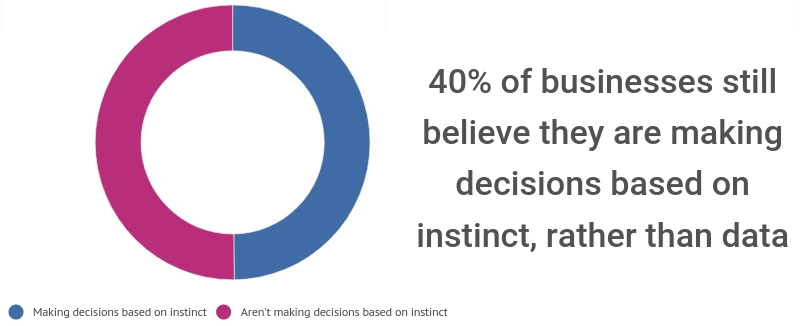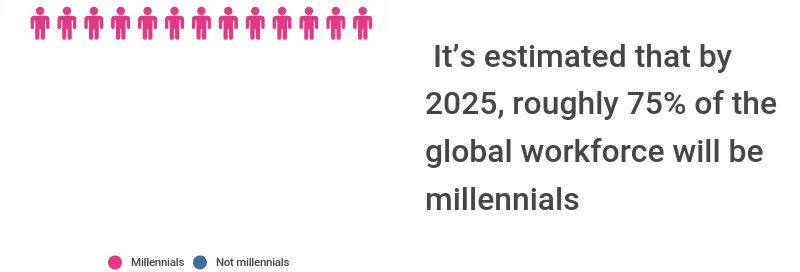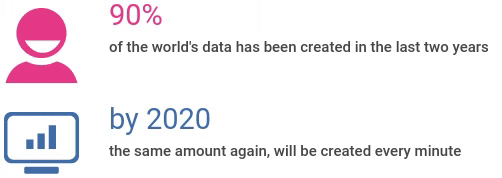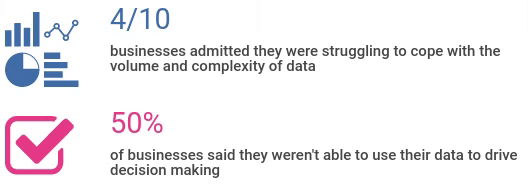We’re already well adapted to so many new technologies both in and outside of the workplace. Many businesses are already using AI and robotics to carry out and automate time-consuming tasks, to allow for increased efficiencies and production across the workforce. Yet, according to our research 40% of businesses still believe they are making decisions based on instinct, rather than data¹.

This may be because data on its own has no intrinsic value. It is the insight and the trends that it contains that brings value. With the veracity and volume of data today there is an opportunity to better understand everyone, including your employees.
From here you can better determine and assess risks and make more accurate predictions on the future well-being of that individual. Having the right insight on potential new candidates, as well as your existing workforce, can create a huge opportunity for HR teams, as it allows for more effective hiring and helps you retain the best talent.
This talent, otherwise known as human capital, is often an organisations most important asset and is therefore fundamental to delivering value through the business model.
It’s estimated that 40% of the Fortune 500 companies won’t exist in 10 years² and so when looking at future growth of your business, leaders need to maximise human capital and you can only do that by attracting, training and retaining the best talent. If you do not, you will not be able to execute against your business strategies effectively.
The changing ways in where we choose to work
Technology has been, and will continue to be, an enabler for humans, yet not a replacement. We embrace it in our personal lives, so why not embrace it in our business lives too?
Advances in devices and software have allowed people to work more flexibly, creating a revolution in the way business is done. We can now work anywhere at any time with the enablement of laptops, smartphones and cloud based systems; we can do business with anyone from anywhere, with the enablement of global systems and communication tools.

But with this change brings changes in the expectations of the people we employ and let’s not forget that millennials are an increasing proportion of our workforce. It’s estimated that by 2025, roughly 75% of the global workforce will be millennials³. This means that the business culture will be driven by the behaviours, beliefs and expectations of this generation. We’re already seeing that with the rate of employment remaining at record high in the UKâ´, the most attractive job seekers are left with numerous options, meaning there is high competition for attracting and retaining top talent. To secure the best workers now and for the future it’s no longer just about a remuneration package.
People, millennials in particular, want a lot more than this. They want to know what an organisation stands for and what impact they can make in achieving its goals. They want to work in a place that makes them feel good, where they can build meaningful relationships. They want to feel a sense of empowerment, purpose and growth. Therefore, organisations need to offer more in order to meet these needs. This doesn’t mean that bean bags and free food automatically make you an attractive place to work. You need a true employee engagement strategy at the heart of your business that will provide long term loyalty rather than short term perks.
It’s still about understanding people: today and tomorrow’s employee
Similar to businesses using insight from consumer data to present their customers with advice and products, based on personal circumstances, wants and needs; these personal circumstances, wants and needs can also drive decisions in the workplace. So, as an employer, you have a chance to tap in to this to present opportunity and predict risk. All types of people data such as age, job family, office location, performance rating, team size, training and proprietary data can be used to provide valuable insight.
Technology is an enabler for this as it allows you to better interpret and analyse data, so that you’re able to use it to understand people on a mass scale. This creates a big opportunity for HR teams, as it enhances the capability of the department, particularly for large organisations. When HR can use this people data to better understand its employees, it too can create an opportunity to ensure it breeds happy, healthy and ultimately productive employees who are going to feel motivated to grow your organisation.
Building employee engagement through insight, to retain top talent
It’s been found that when it comes to spending disposable income, experiential purchases tend to make people happier than material purchases. So, when thinking about keeping your employees happy, adding more ‘perks’ will only result in short-term happiness. This is ok, but as a strategy, it is an expensive model to adopt, and ineffective in the long-term. And if when people invest in an experience, they become happier over time, it makes sense to build employee engagement programmes based on experience. But in order to know what programmes will be successful in your organisation, you need to understand your workforce, and unless you have an excess of time and resource, this is where the use of your people data with technology will come in to help identify patterns and build insight across your entire workforce, even if this workforce is 10,000 or more strong.
We’re already seeing the evidence of this through our own analytics which demonstrates that salary increases and monetary based reward initiatives don’t have a significant impact on the retention of staff, compared to factors around team dynamics, manager performance and work/life balance and flexibility.
If you don’t currently have employee data from which you can allow technology to begin analysing, then this is a crucial point that you need to accelerate now.
Without this data, from demographics such as age and location to individual data such as performance score, team size and distance to work, you won’t be able to gain the valuable insight you need to understand and grow your workforce.
Enabled by technology, people are also driven to work in a more agile way, having a choice in the way they contribute to the business. From permanent, contingent, contractor, freelance, consultant, full-time, part-time, temporary and more, people are more frequently choosing how and when they contribute to a company. In fact, considering this, the word “contributor,” not “employee,” may be a better representation of future workers. The role of HR in this world becomes ever more important as the complexity and variety of the work force means more tailored employee programmes are required to harness the right talent in the most appropriate way. This can be done through identifying trends and patterns amongst your employees and grouping them appropriately. Achieving this is far from straightforward, but with the help of technology and a focused and driven HR team, you can lead the way in the future of work.
A data-driven HR future
We’ve already entered the beginning of the data-driven world. In fact, 90% of the world’s data has been created in the last two years and by 2020, the same amount of data again, will be created every minute. But with so much information available it can be overwhelming to think about how to extract the relevant insight. Before data can be used, it needs to be interpreted and understood. That’s where analytics comes in. Technology has advanced just as quickly as our data universe has expanded, and today’s analytics can make better sense of data – at scale, and at speed – more accurately than any human. For HR teams, this means you can understand candidates during the recruitment process; presenting you with insight that allows you to make the right decision on the people you choose to recruit. Having well-matched individuals to your organisation not only reduces the cost of a bad-hire, but also helps reduce your attrition rate when you employ the ‘right’ people; people whose values, behaviours and expectations are matched to the role and your organisation. Applying this to your existing workforce gives you better insight in terms of performance management, engagement and remuneration.

While data analytics was previously used to solve existing problems, today we begin with data and use it to uncover patterns, spot anomalies and therefore problems, and predict or identify new opportunities. If HR can use such analysis to drive decisions around the workforce, then businesses most important asset, its people, will be well protected and opportunities for growth will be easily identified. However, four in ten businesses admitted they were struggling to cope with the volume and complexity of data and half said they weren’t able to use their data to drive decision makingâµ.

At Experian we are already using these techniques for our own global HR function and that of other large organisations to deliver measurable return on investment through the retention of talent. As technology continues to advance, these capabilities are sure to grow. Therefore, focus on enhancing HR analytics capability, needs to be a priority now if businesses want to stay ahead in the data-driven world.
Talk to us about how Experian can help you in enhancing your HR analytics capability.
¹ https://www.experian.co.uk/assets/business-services/white-papers/experian-business-review.pdf
² John Olin School of Business, Washington University. Fortune 500 companies on S&P 500
â´ https://www.gov.uk/government/news/employment-rate-remains-at-record-high
